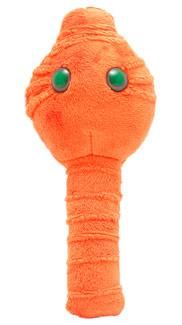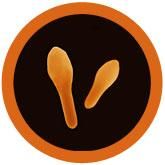Botulism (Clostridium botulinum)
Out of Stock
Product Details
Additional Information
| Sizes | Giantmicrobes are based on actual microbes, cells, organisms and other critters, only 1,000,000 times actual size! Gigantic (GG) 40-60cm XL (XL) 25-38cm Original (PD) 12-20cm Minis (MM) 5-10cm each Keychain (KC) 5-10cm with clip |
|---|---|
| Materials | Plush from all new materials. Stuffed with polyester fiber fill. Surface washable: sponge with water & soap, air dry. |
| Packaging | Each plush microbe includes a printed card with fun, educational and fascinating facts about the actual microbe or cell. |
| Safety | Every product meets or exceeds U.S. and European standards for safety. For ages 3 and up. |
All about Botulism (Clostridium botulinum)
Botulism, Latin for ‘sausage disease,’ was first recognized in 1735 as a form of food-poisoning in German sausages. It is caused by Clostridium botulinum, which produce a neurotoxin that is the most poisonous natural substance known (and has even been developed as a biological weapon).
Fortunately, C. botulinum is usually quietly domiciled in soil, streams, and lakes, and ventures into the food-chain only on occasion. It is typically found in canned foods where the bacteria propagate at their leisure, using their toxin to breakdown energy supplies.
Proper food preparation (i.e., heat) can destroy the toxin. But if it is not destroyed, even low doses can produce double-vision, difficulty breathing, and even paralysis. Infants are particularly susceptible to C. botulinum infection, as the internal flora and acidic content of their intestines is undeveloped. (Honey is a common transmission pathway for infants, and should be avoided.)
But C. botulinum has a helpful side as well. It turns out paralysis isn’t such a bad thing – if you’ve got wrinkles. Injecting minute quantities of botulinum toxin into facial muscles paralyzes them, and diminishes the appearance of aging lines.
Botulinum toxin also has a number of more serious medical uses. It can alleviate muscle spasms, chronic lower back pain, migraine headaches, crossed-eyes, and even excessive sweating!
So, while the sausage disease can unquestionably bring out the wurst in people, sometimes it is precisely what the doctor ordered.
| Where It Lives | Botulism causing bacteria live in soil, so they can contaminate food, wounds, and unsuspecting infants. Botulism food poisoning is associated with improper canning techniques. It is not contagious. |
|---|
| Symptoms | Clostridium botulinum bacteria produce neurotoxins, which ultimately affect muscles. Symptoms include droopy face, slurred speech, and all things related to lethargy and weak muscles. This disease can cause paralysis and death. |
|---|
| Cure | Antitoxins work to slow effects and encourage recovery. |
|---|
| History |
1735: Botulism poisoning first linked with sausage in Germany. 1897: Emile van Ermengem discovered and named botulism from studying ham that spawned an outbreak. Big Outbreaks: 1919: 19 dead from botulism derived from canned ripe olives. 1977: 58 infected from canned jalapenos at a Michigan restaurant. 1978: 2 dead and 33 infected from canned beans in New Mexico. Recent Outbreaks: 2015: 1 dead and 23 infected from a church potluck in Ohio. |
|---|
| Fascinating Facts |
The Botulinum toxin so poisonous that it was considered for biological warfare during WWII. The Botulinum toxin is used to treat some muscle spasm conditions. This toxin is used in Botox to smooth face wrinkles for a younger appearance - great gift for a doctor or a cosmetic surgeon. |
|---|






